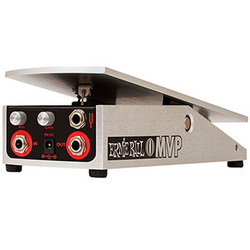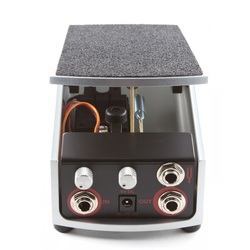
Ernie Ball – MVP Most Valuable Pedal
By John Knowles
For the guitarist with a variety of guitars in their arsenal with various pickup setups, the Ernie Ball MVP volume pedal is the perfect companion. While the classic VP Jr. pedals have been a staple of many players rigs for years, the problem many saw was the fact that there were two different models that better catered to instruments with passive pickups and active pickups respectively. The MVP meets this challenge, and succeeds with flying colors. Thanks to separate volume and gain controls, players can dial in a precise sound signature to meet the demands of any guitar configuration while preserving one’s tone throughout even the most eclectic concert sets.
A look at the front of the MVP reveals six different features. There’s the standard mono input and output for placement anywhere in a pedal signal chain, a 9 volt DC power adapter input, and then the true goods of the pedal; First up is the MIN knob. At fully counter clockwise, this knob adjusts the heel down position of the pedal from no volume to a desired rhythm level, up to 50%. Next to the MIN knob is arguably the real value of this pedal: the GAIN knob. The GAIN knob allows users to adjust the toe down position beyond the standard 100% like most other volume pedals. Additional gain can be added up to 20db, making this the perfect aid for a great solo or lead boost.
Metal Exiles put the MVP to the test by plugging in a Fender Strat equipped with stock, passive pickups, and a Jackson Soloist equipped with active EMG pickups. The gain of an active EMG is naturally high, so the test began with the Soloist with the intention to boost the level on the pedal once the Fender was used. Setting the MIN and GAIN knob at about 12 o’clock in the heel down position produced a very nice rhythm level. In the toe down position the level really popped, and produced a soaring lead tone with just enough extra gain to not muddy the tone, but to allow the notes to really stand out. Next, the Fender was plugged in with the same settings, and the response was the same – great rhythm level and a killer solo level and tone. The last test was to see just how feasible and simple it is to achieve a similar decibel level with both guitars.
In a live setting not all soundmen are created equal, so its important that when switching axes between songs, a player can know that their output has remained unaffected by an instrument swap. For the purposes of this review, the simplest way to gauge the output level was to connect the MVP into a ProTools rig and observe the level meter in the Mix Window. Once again the Jackson was first to establish a peak level, and the Fender followed to reach the latter. It only took a few clicks of the GAIN knob to achieve a comparable level. For many players, using their ears in this scenario will suffice, but for the purposes of this review a slightly more precise method was used. It can be safely concluded that the MVP provided the necessary element to achieving pure sonic satisfaction. The slight adjustment in gain by no means over-saturated the tone, but simply provided the necessary level boost.
The last feature is the separate tuner “out.” This is a very handy feature, especially for signal chain users. The tuner output functions at any volume, with any tuner. If your pedalboard power supply is full, simply plug your tuner into the MVP. The one drawback is that your tuner can no longer serve as your board’s killswitch, however, if your MIN knob is set at fully counter clockwise (0%), than the MVP can serve this purpose, and you can successfully save an input on your board’s power supply. Another plus is that your tuner can remain on at all times without any signal disturbance, allowing you to observe your tuning mid-song, especially when playing individual notes that ring out.
Compared to previous VP Jr. models from Ernie Ball there is definitely an improvement in the sweep of the pedal for a more ideal volume control. The pedal rocks comfortably with just enough tension to hold at any position, and still allow for a smooth transition while doing volume swells. A 9V battery compartment can be found on the bottom of the pedal, which is very easily accessible.
The bottom line: The MVP is an amazing volume pedal for musicians of all styles of music. For the metal player, the added GAIN knob is an especially valuable feature, and will allow your leads to stand out like never before. In a pinch, a metal player could walk onstage with only the MVP connected to their rig and be basically good to go with a comfortable rhythm level, and the option to add up to 20db of face-melting lead gain. Even without the GAIN feature, the MVP stands as an improvement on previous mono VP models for reasons previously mentioned. The easy-to-use and very affordable MVP is a must for any guitarist’s rig.
Visit Ernie Ball’s official site here.
BUY the Ernie Ball MVP here
Product Demo from Guitar Noize
By John Knowles
For the guitarist with a variety of guitars in their arsenal with various pickup setups, the Ernie Ball MVP volume pedal is the perfect companion. While the classic VP Jr. pedals have been a staple of many players rigs for years, the problem many saw was the fact that there were two different models that better catered to instruments with passive pickups and active pickups respectively. The MVP meets this challenge, and succeeds with flying colors. Thanks to separate volume and gain controls, players can dial in a precise sound signature to meet the demands of any guitar configuration while preserving one’s tone throughout even the most eclectic concert sets.
A look at the front of the MVP reveals six different features. There’s the standard mono input and output for placement anywhere in a pedal signal chain, a 9 volt DC power adapter input, and then the true goods of the pedal; First up is the MIN knob. At fully counter clockwise, this knob adjusts the heel down position of the pedal from no volume to a desired rhythm level, up to 50%. Next to the MIN knob is arguably the real value of this pedal: the GAIN knob. The GAIN knob allows users to adjust the toe down position beyond the standard 100% like most other volume pedals. Additional gain can be added up to 20db, making this the perfect aid for a great solo or lead boost.
Metal Exiles put the MVP to the test by plugging in a Fender Strat equipped with stock, passive pickups, and a Jackson Soloist equipped with active EMG pickups. The gain of an active EMG is naturally high, so the test began with the Soloist with the intention to boost the level on the pedal once the Fender was used. Setting the MIN and GAIN knob at about 12 o’clock in the heel down position produced a very nice rhythm level. In the toe down position the level really popped, and produced a soaring lead tone with just enough extra gain to not muddy the tone, but to allow the notes to really stand out. Next, the Fender was plugged in with the same settings, and the response was the same – great rhythm level and a killer solo level and tone. The last test was to see just how feasible and simple it is to achieve a similar decibel level with both guitars.
In a live setting not all soundmen are created equal, so its important that when switching axes between songs, a player can know that their output has remained unaffected by an instrument swap. For the purposes of this review, the simplest way to gauge the output level was to connect the MVP into a ProTools rig and observe the level meter in the Mix Window. Once again the Jackson was first to establish a peak level, and the Fender followed to reach the latter. It only took a few clicks of the GAIN knob to achieve a comparable level. For many players, using their ears in this scenario will suffice, but for the purposes of this review a slightly more precise method was used. It can be safely concluded that the MVP provided the necessary element to achieving pure sonic satisfaction. The slight adjustment in gain by no means over-saturated the tone, but simply provided the necessary level boost.
The last feature is the separate tuner “out.” This is a very handy feature, especially for signal chain users. The tuner output functions at any volume, with any tuner. If your pedalboard power supply is full, simply plug your tuner into the MVP. The one drawback is that your tuner can no longer serve as your board’s killswitch, however, if your MIN knob is set at fully counter clockwise (0%), than the MVP can serve this purpose, and you can successfully save an input on your board’s power supply. Another plus is that your tuner can remain on at all times without any signal disturbance, allowing you to observe your tuning mid-song, especially when playing individual notes that ring out.
Compared to previous VP Jr. models from Ernie Ball there is definitely an improvement in the sweep of the pedal for a more ideal volume control. The pedal rocks comfortably with just enough tension to hold at any position, and still allow for a smooth transition while doing volume swells. A 9V battery compartment can be found on the bottom of the pedal, which is very easily accessible.
The bottom line: The MVP is an amazing volume pedal for musicians of all styles of music. For the metal player, the added GAIN knob is an especially valuable feature, and will allow your leads to stand out like never before. In a pinch, a metal player could walk onstage with only the MVP connected to their rig and be basically good to go with a comfortable rhythm level, and the option to add up to 20db of face-melting lead gain. Even without the GAIN feature, the MVP stands as an improvement on previous mono VP models for reasons previously mentioned. The easy-to-use and very affordable MVP is a must for any guitarist’s rig.
Visit Ernie Ball’s official site here.
BUY the Ernie Ball MVP here
Product Demo from Guitar Noize


